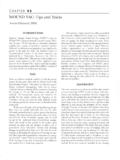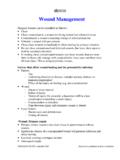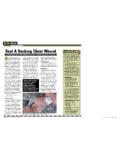Transcription of BASIC WOUND MANAGEMENT OF HORSES
1 BASIC WOUND MANAGEMENT OF HORSES . -The BASIC nature of HORSES seems to put them at risk for traumatic injuries. One of the most common reasons that clients present their HORSES to the veterinarian is trauma that results in skin and soft tissue wounds. Most often wounds occur on horse's limbs and are caused by foreign objects such as fences, gates, farm implements and building materials. Wounds on the distal limbs of HORSES can be especially difficult to manage because of poor circulation, joint movement and minimal soft tissue between skin and bone. There is also always the risk of contamination from the environment. - WOUND healing, by definition, is "the restoration of the normal anatomic continuity to a disrupted area of tissue.". *In order to successfully manage wounds in HORSES , we must first understand the normal process of WOUND healing. The Four Stages of WOUND Healing: 1. Inflammation: the first stage of WOUND healing begins immediately following an injury. Vasoconstriction facilitates homeostasis (stops or slows hemorrhage).
2 Vasodilatation quickly follows, allowing healing properties to leak into the WOUND area. 2. Debridement: the process by which exudates (pus) develops in order to remove infection and debris from a WOUND . 3. Repair: Consisting of fibroblasts, capillary and epithelial cell growth and proliferation. Fibroblasts are the cells that build the framework for reconstruction of a WOUND . Capillary migration occurs to provide blood supply, and epithelial cells migrate across wounds to re- establish skin continuity. 4. Maturation: New reconstruction tissues are organized, providing WOUND strength over time. Initial WOUND MANAGEMENT and Evaluation 1. Restrain and calm the horse. Assess the overall health, condition, and stability of the horse. An injured horse may be suffering from hemorrhagic (hypovolemic) shock, head injuries or long bone fractures. 2. Active bleeding may be controlled by direct pressure. This is best done by applying a thick, absorbent lint-& dressing with elastic bandage material.
3 Fractures should be stabilized *Once the horse is deemed stable, and hemorrhage has been controlled, the WOUND should be closely evaluated. *At this point one can decide if a veterinarian is needed to treat the horse. Types of Wounds: 1. Puncture wounds Penetrating wounds that generally look minor by making small skin tears or holes, but can cause significant trauma beneath. Most puncture wounds are complicated by infection, because contamination is introduced deep into the WOUND . Often, the skin heals before the underlying tissue. These wounds should be cleaned, lavaged, and encouraged to drain and remain unsutured. 2. Incised wounds Generally slicing type wounds that have smooth and clean edges, caused by sharp objects. After thorough cleaning, these wounds are usually best suited for primary closure (suturing, stapling, or gluing). 3. Lacerations Generally traumatic injuries that leave rough, jagged edges of skin and possibly underlying soft tissue damage. These wounds are at greater risk for infection due to contamination and generally require some debridement.
4 Depending of the severity and location of the WOUND , second intention healing or open WOUND MANAGEMENT may be the treatment of choice. 4. Abrasions Non-penetrating wounds of the skin. These wounds are generally minor, and other that cleaning, require minimal treatment. WOUND Treatment Once a decision has been made on who will manage the WOUND , the treatment can begin. 1. WOUND Cleaning: The initial goal when preparing a WOUND for primary treatment is to decrease the threat of infection by cleaning the WOUND . If possible, hair near the WOUND edges should be removed prior to cleaning. A water soluble sterile gel should be applied to the WOUND to keep hair and debris from contaminating the site. Mild antiseptic solutions are generally used to clean the WOUND edges, but not deep wounds. Copious lavage or irrigation of the WOUND will wash away visible and microscopic debris and organisms. The best solution for irrigation is sterile saline with or without dilute antiseptics (Povidine Iodine or Chlorhexadine).
5 2. Debridement: The removal of dead and/or dying tissue. Often times wounds are not discovered for hours or even days and portions of traumatized tissue may start to die. Devitalized and necrotic tissue may have to be surgically removed in order to facilitate healing. Once initial inspection, WOUND cleaning, and debridement have taken place, the decision to close the WOUND or manage it as an open WOUND can be reconsidered. The amount of contamination, infection, age of WOUND , and the availability of skin are all factors that dictate whether to close a WOUND or not. *Primary Closure: WOUND closure at the time of initial exam. Wounds may be closed primarily by sutures, staples, or glue. These are the easiest wounds to manage. (Incised wounds). *Delayed primary closure: Closing a WOUND after several days, generally after daily lavage and debridement. (Contaminated incised wounds or a minor laceration). *Open WOUND MANAGEMENT : Often times, veterinarians are unable to close traumatic injuries to horse's limbs, subsequently; these wounds are left to heal by second intention and managed as open wounds.
6 With appropriate treatment and bandaging techniques, these wounds can heal completely. Large lacerations, degloving injuries of the distal extremities are commonly treated as open wounds. Open WOUND MANAGEMENT consists of repeated cleaning, lavaging, debridement and bandaging. Wounds on the trunk, head, and upper limbs are difficult to bandage. p- Bandaging types and techniques play a critical role in managing open wounds in HORSES . Recent studies on equine WOUND healing have lead to better bandaging material and techniques. The appropriate WOUND dressing is very important when treating open wounds. Studies indicate that open wounds heal better and faster if they are allowed to heal in a regulated, moist, environment, especially during the initial stages of treatment. Moist WOUND healing occurs when WOUND exudates are allowed to stay on the surface of the WOUND . As long as there is no bacterial colonization on the WOUND surface, the exudates will provide cellular components that improve the healing process.
7 Specially formulated WOUND dressings like calcium alginate and absorbent foam pads work well to provide a moist, WOUND healing environment. Excessively exudative or contaminated wounds or wounds with bacterial colonization may require a WOUND dressing that will help remove cellular debris and bacteria. Many practitioners rely on wet to dry dressings for this purpose. Antibacterial impregnated woven gauze are saturated with saline and applied to the WOUND surface. This is then bandaged with secondary and tertiary layers. Once this WOUND dressing is removed, it takes with it cellular debris, contamination, and bacteria. Topical antimicrobial ointments are not necessary when treating wounds that are surgically closed, but they are commonly used for dressing open wounds. Ideal topical dressings should be water-soluble, non-drying and non-irritating. In my opinion, timely bandage changes with appropriate bandage material and repeated antiseptic lavage are the best methods for controlling superficial infection.
8 Exuberant granulation tissue or "proud flesh" is a common side effect of open WOUND MANAGEMENT of distal limb wounds in HORSES . Granulation is part of the normal healing process of open wounds, but excessive granulation may impede contraction and epithelialization. Exuberant granulation tissue may require surgical excision or topical treatment. Caustic dressings and topical steroid preparations may be used to control proud flesh. Caustic dressings indiscriminately destroy tissue and topical steroids markedly decrease moisture and shrink the granulation bed by contraction. The use of both of these methods is controversial and should be used based on your veterinarian's experience and assessment. Bandages Bandages are an important aspect of WOUND MANAGEMENT , especially wounds on the distal limbs. The specific purposes for bandages include controlling hemorrhage, preventing WOUND desiccation, absorbing exudates, aiding debridement, immobilizing an area of movement (wounds near joints), and preventing further trauma or contamination.
9 When applying bandages, several principles must be understood to avoid possible serious complications. Bandages should supply protection and treatment for the WOUND , provide sufficient padding to provide even pressure on the limb, and be applied so it will not move and should consist of three or four layers. 1. The first layer of the bandage is in direct contact with the WOUND and may be adherent or non-stick dependent on the desired function. Examples of first layer WOUND dressings: *Non-stick telfas *Amorphous gel dressings *Calcium alginate dressings *Woven or non-woven gauze *Foam pad dressings This first layer bandage may be held in place by a soft thin, elastic or cotton wrap. 2. The second layer of bandage material functions to provide padding, absorb fluid, provide support, and immobilize the limb if necessary. Examples of second layer bandage material: Roll cotton Cotton combine Quilt/pillow padding Sheet cotton 3. The third layer of a bandage is used to hold the other layers in place, apply pressure, and protect the first two layers from the environment.
10 Examples of third layer: Vetwrap Powerflexm Coflex all of these are cohesive elastic wraps 4. A fourth bandage layer may be necessary or desired to provide added stiffness and pressure, improve durability, and hold the bandage in place. This bandage should be elastic and adhesive. Examples of Fourth Layer: Elasticon Expandover General Principles for Applying Bandages *Always start with clean, dry, legs and bandage material. *Treat the WOUND as recommended by your veterinarian. 1. Apply your chosen primary layer to the WOUND and hold it in place with a non-adherent, nonconstricting elastic or cotton wrap. 2. Apply the padding layer of the bandage. Use an appropriate width to cover the WOUND and any joint(s) that need to be immobilized. Use enough length to provide approximately one inch of thickness. Start the padding layer on the inside of the leg and wrap from front to back and outside to inside. (Clockwise on right legs and counter- clockwise on the left legs.) Be careful to avoid wrinkles.






